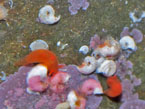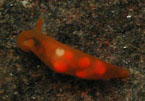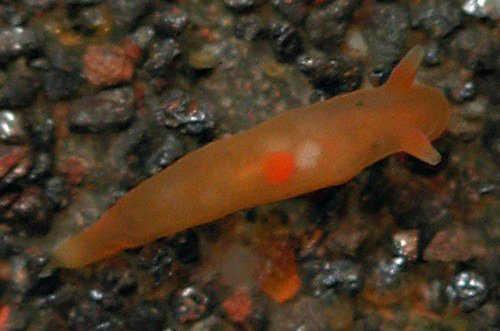_______________
Additional Photos

with spirorbid worms

carrying eggs

egg mass
_______________
GALLERY

|
Vayssierea felis (Collingwood, 1881)

Maximum size: 4 mm (Kay, 1979).
Identification:
This
is a tiny, bright orange species with a soft body and no gills.
Natural history:
Although seldom
noticed due to its small size,
Vayssierea
felis is a moderately common species. We've found it under rocks
in the mid to low intertidal on cobble beaches, in moderately protected
to moderately exposed rocky areas down to 5 m (16
ft) and in Halimeda
kanaloana beds down to at least 11 m (36 ft). It feeds on
spirorbid and serpulid polychaetes by boring through their tubes (Kay,
1979). Unlike in most Hawaiian nudibranchs, the eggs develop directly
and are proportionately large, for the animal, with unlaid eggs often
showing through the body wall as orange masses. A 1.8 mm animal laid an
arc-shaped mass of seven eggs that hatched in 13 days in the
laboratory. The freshly hatched juveniles were about 0.8 mm in length.
Distribution:
Big Island, Maui, Oahu and Kauai: widely distributed in the Indo-Pacific.
Taxonomic notes:
This
is the species listed as Okadaia
elegans Baba, 1931 in Kay, 1979 as well as Kay & Young, 1969.
It was first reported from
Hawaii in Kay & Young, 1969. There is some chance that intertidal
and subtidal populations might turn out to be separate, cryptic species.
Photo: CP:
1.7 mm: Honanana, Maui; July 8, 2005.
Observations and comments:
Note
1: ( )
|
|




